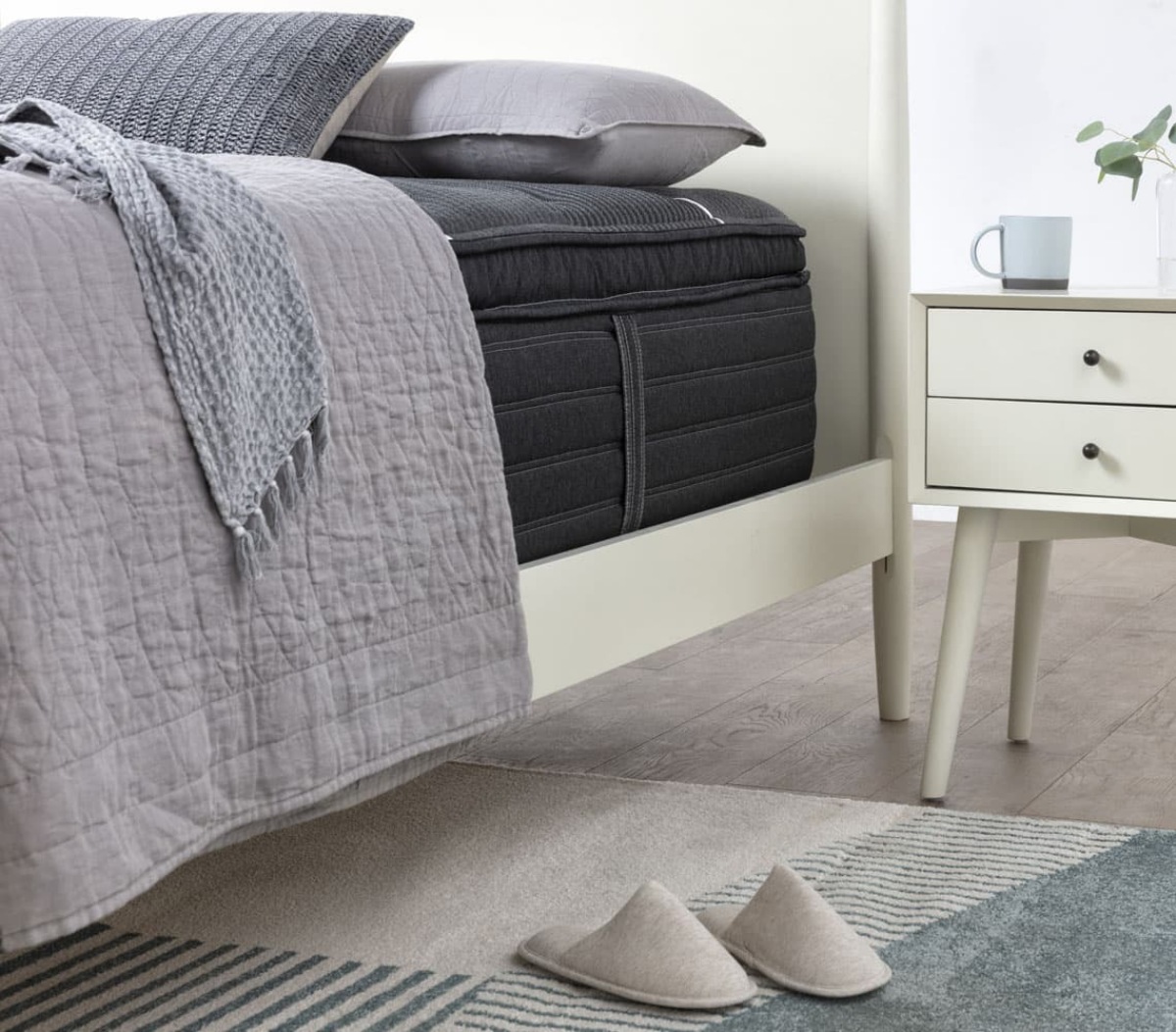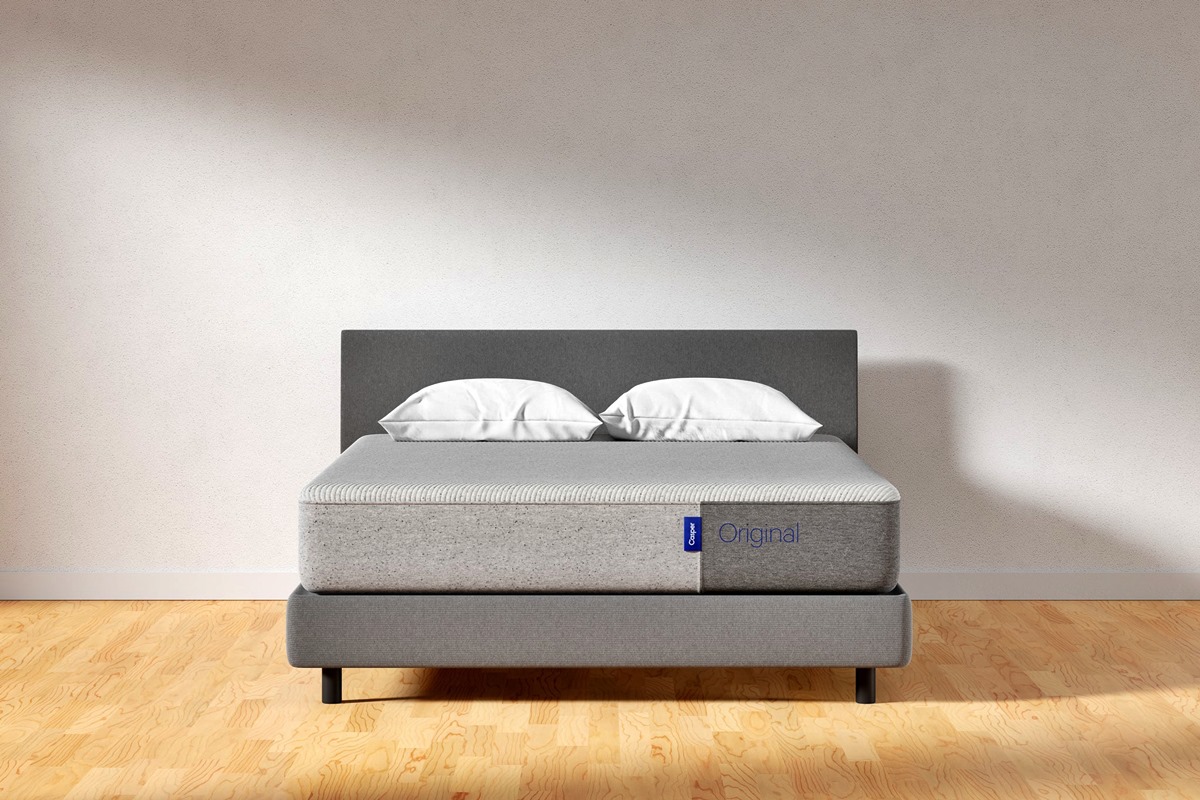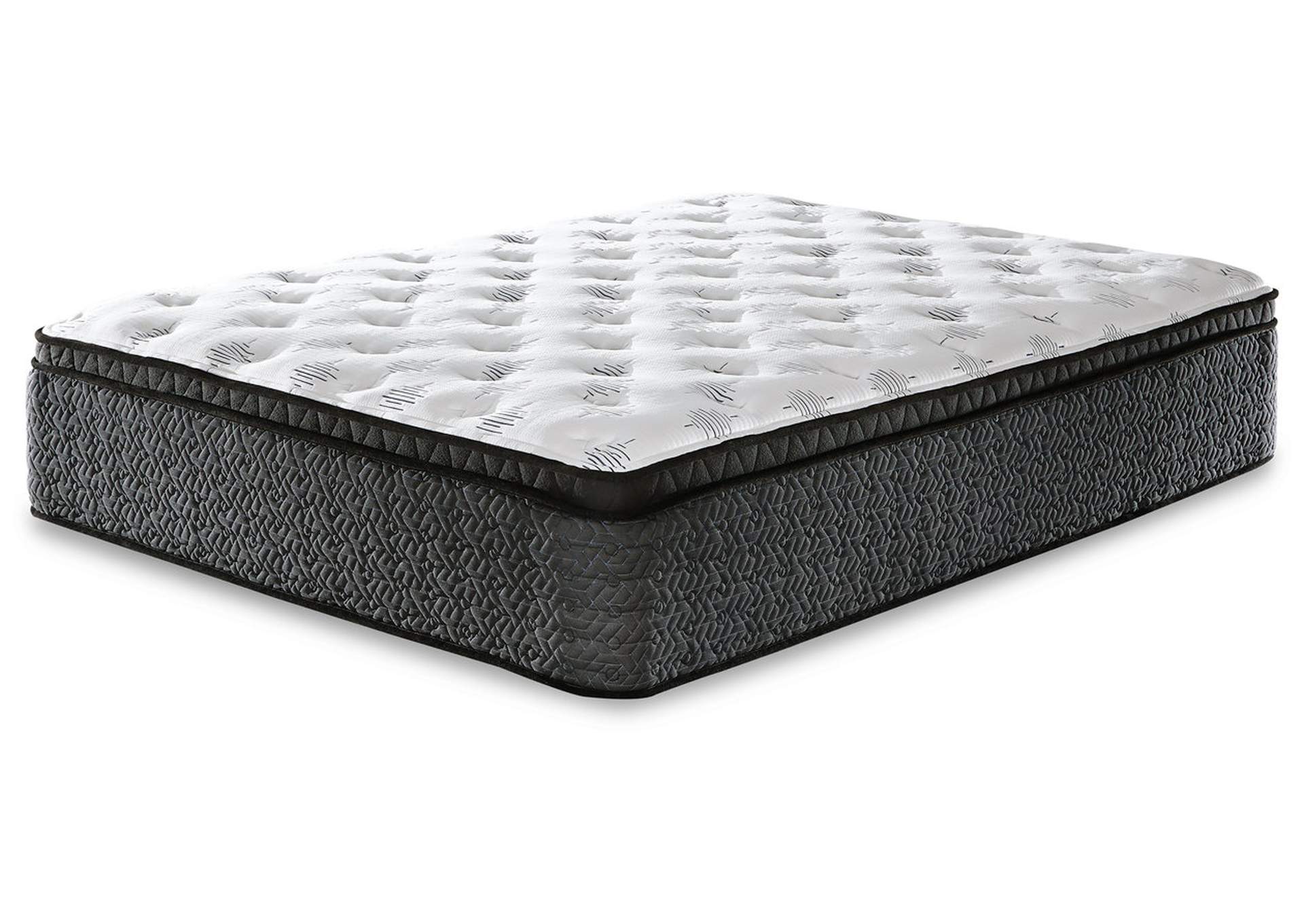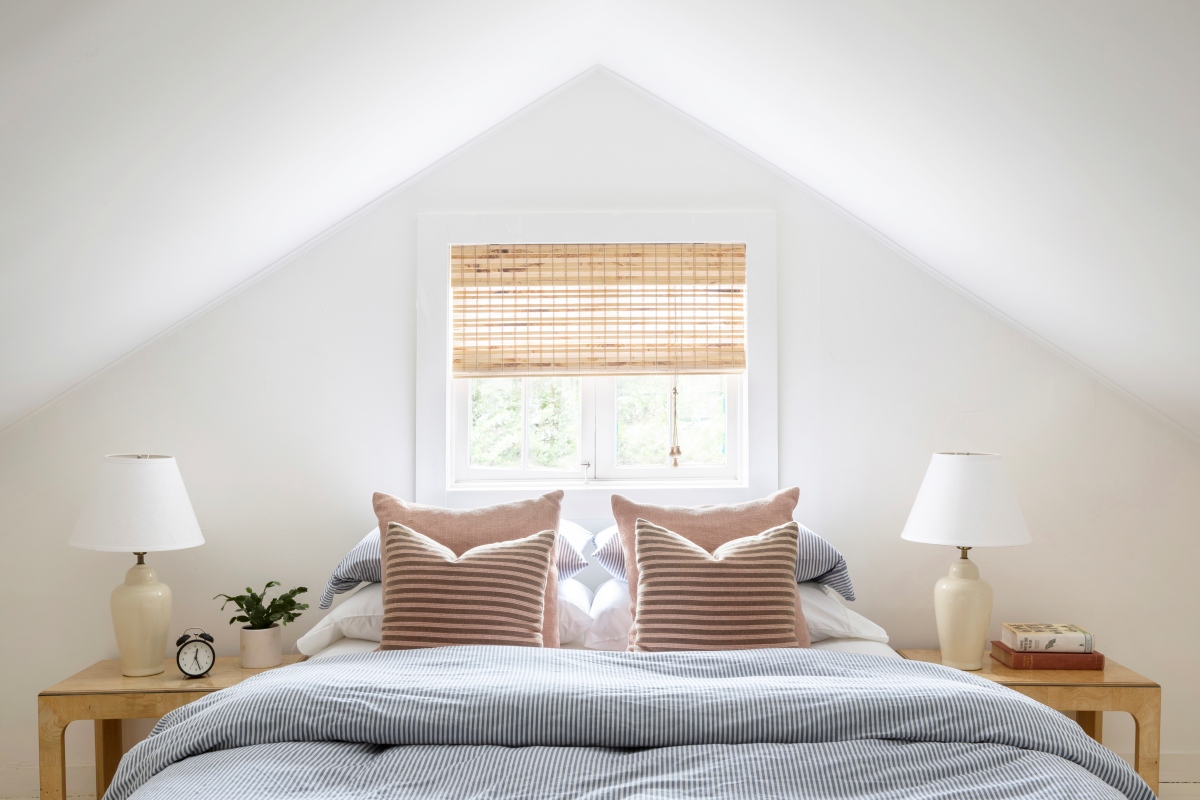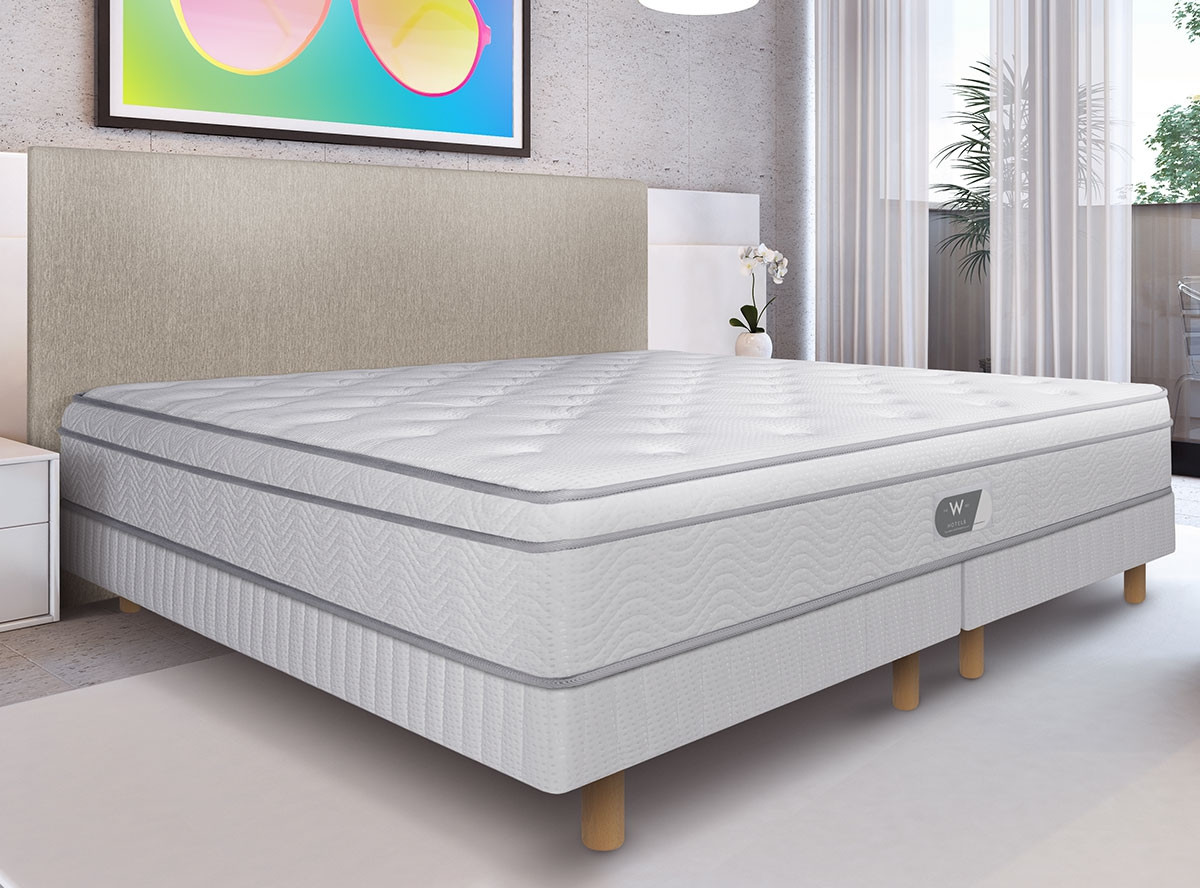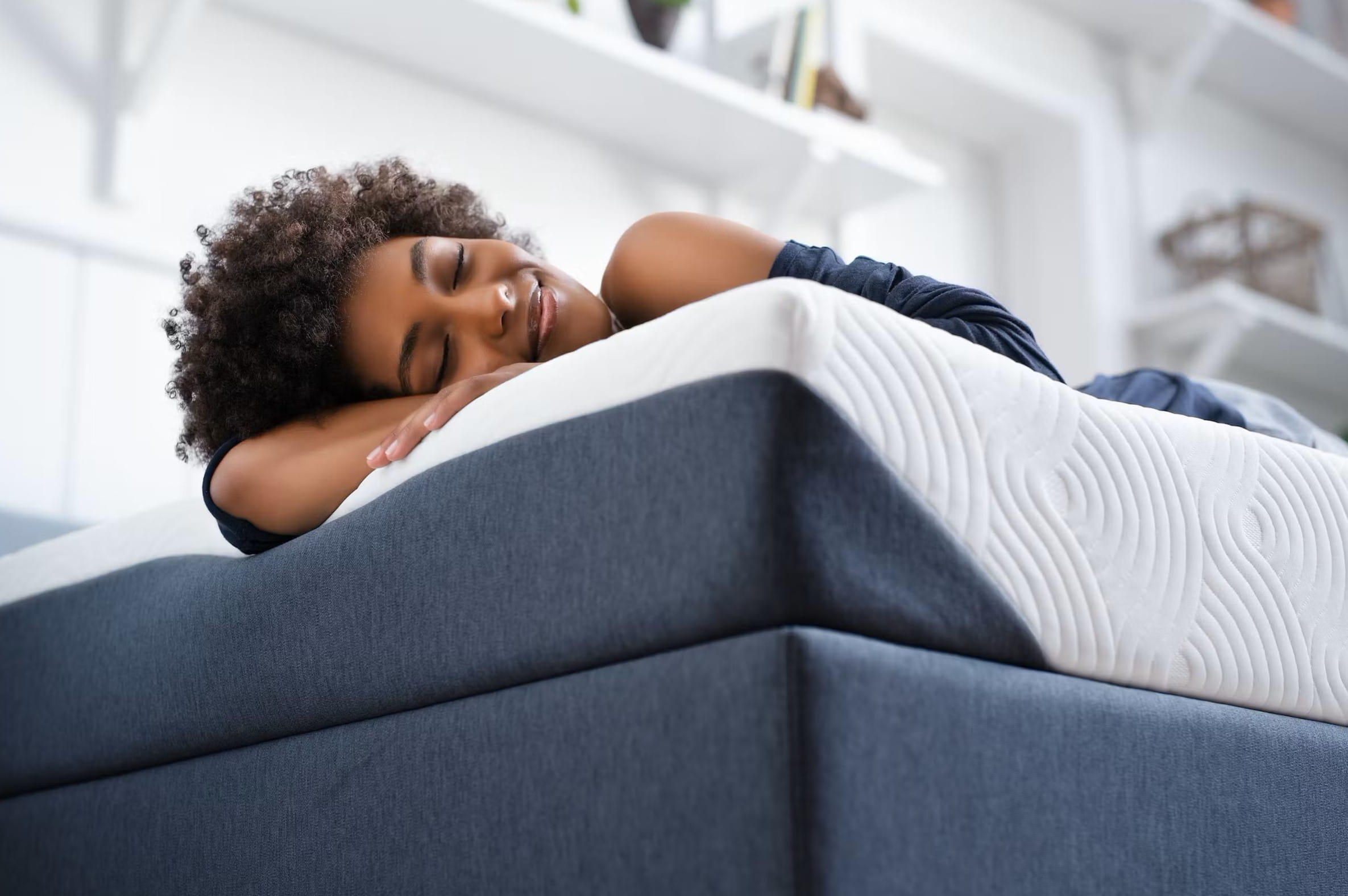Home>Furniture>Bedroom Furniture>How To Make A Mattress Harder


Bedroom Furniture
How To Make A Mattress Harder
Modified: October 20, 2024
Learn how to make your mattress harder with the right bedroom furniture. Transform your sleeping experience for improved comfort and support.
(Many of the links in this article redirect to a specific reviewed product. Your purchase of these products through affiliate links helps to generate commission for Storables.com, at no extra cost. Learn more)
Introduction
When it comes to getting a good night’s sleep, having the right mattress is crucial. However, not everyone prefers a soft and plush surface to sleep on. Some individuals may find that a firmer mattress provides better support and helps alleviate their back pain or discomfort. If you have found yourself in this situation, you may be wondering how to make your mattress harder.
Adjusting the firmness level of your mattress can be a cost-effective and simple solution that allows you to customize your sleeping experience. In this article, we will explore various methods to make a mattress harder, from adjusting the foundation to using mattress toppers and more.
Before diving into the different techniques, let’s first understand why mattress firmness matters. The level of firmness refers to how soft or hard a mattress feels when you lie down. It plays a vital role in providing proper support to your body, aligning your spine, and reducing pressure points. The ideal mattress firmness level varies from person to person, as it depends on factors such as body type, sleeping position, and personal preferences.
Now that we have a basic understanding of the importance of mattress firmness, let’s explore some effective methods to make a mattress harder.
Key Takeaways:
- Achieving the ideal mattress firmness is crucial for quality sleep. Methods such as adjusting the foundation, using a firm mattress topper, and seeking professional advice can help customize your mattress for optimal comfort and support.
- Proper air circulation, removing extra cushioning layers, and flipping or rotating the mattress are practical ways to maintain mattress firmness. Seeking professional assistance can provide tailored solutions for achieving the desired level of firmness.
Read more: How To Make A Mattress Softer
Understanding the Importance of Mattress Firmness
When it comes to selecting a mattress, the level of firmness is a crucial factor that can significantly impact your sleep quality and overall well-being. Let’s take a closer look at why mattress firmness is so important:
1. Spinal Alignment: A proper mattress firmness level ensures that your spine remains aligned while you sleep. When a mattress is too soft, your body tends to sink in, causing misalignment and potential back pain. On the other hand, a mattress that is too firm can put excessive pressure on certain areas of your body, leading to discomfort.
2. Pressure Point Relief: Different individuals have different pressure points, which are areas where the body releases pressure while lying down. An appropriate level of mattress firmness helps distribute your body weight evenly, relieving pressure and preventing pain and discomfort in certain areas like the hips, shoulders, and knees.
3. Comfort and Support Balance: Finding the right balance between comfort and support is essential for a good night’s sleep. While a soft mattress may feel comfortable initially, it often lacks the necessary support for your body. A firmer mattress provides better support, ensuring your body is properly supported throughout the night.
4. Sleep Posture Support: Your sleeping position plays a vital role in determining the ideal mattress firmness. Different positions require different levels of support. For example, side sleepers may benefit from a slightly softer mattress to relieve pressure points, while back and stomach sleepers may prefer a firmer surface for better spinal alignment.
5. Durability: The firmness level of a mattress can also impact its lifespan. A mattress that is too soft may sag and lose its shape over time, resulting in a shorter lifespan. A firmer mattress tends to be more durable and maintains its support for a longer period.
By understanding the importance of mattress firmness, you can make informed decisions about the level of firmness that suits your needs and preferences. If you have a mattress that is too soft and prefer a firmer surface, there are various methods you can try to achieve the desired level of firmness. Let’s explore these methods in the next section.
Methods to Make a Mattress Harder
If your mattress is too soft and you want to make it harder, there are several effective methods to achieve the desired level of firmness. Let’s delve into these methods:
- Adjusting the Foundation: One of the easiest ways to make a mattress firmer is to adjust or change the foundation it sits on. If your mattress is on a box spring, consider replacing it with a solid foundation or placing a piece of plywood between the mattress and the box spring. This can provide additional support and make the mattress feel firmer.
- Using a Mattress Topper: While it may seem counterintuitive to add a topper to make a mattress harder, there are firm mattress toppers available in the market. These toppers are specifically designed to enhance the firmness of a mattress. Look for options made from materials like latex or memory foam, as they can provide the desired firmness and support.
- Adding a Plywood Board: Placing a plywood board between the mattress and the foundation can offer extra support and make the surface feel firmer. Measure the size of your mattress and have a plywood board cut to fit underneath. This method can help reduce the sinking feeling and add firmness to the mattress.
- Replacing the Box Spring: If your mattress is on a box spring that is old or worn out, consider replacing it. Over time, box springs can lose their firmness and sag, affecting the overall support of the mattress. Opt for a new box spring or a more solid foundation to improve the firmness of the mattress.
- Flipping or Rotating the Mattress: If your mattress is double-sided or designed for rotation, try flipping or rotating it. Over time, mattresses can develop body impressions and lose their firmness in specific areas. Flipping or rotating the mattress can help distribute body weight more evenly and potentially make the surface feel firmer.
- Removing Extra Cushioning Layers: Some mattresses come with additional cushioning layers that can contribute to a softer feel. If possible, unzip the cover and remove any extra layers or padding. This can help reduce the plushness and increase the overall firmness of the mattress.
- Allowing for Proper Air Circulation: Proper air circulation can prevent the mattress from retaining heat and becoming softer over time. Ensure that your mattress is placed on a breathable mattress protector or cover and that there is adequate airflow in your bedroom. This can help maintain the desired level of firmness.
- Seeking Professional Assistance: If you have tried various methods and are still not satisfied with the firmness of your mattress, consider consulting a professional. Reach out to a mattress specialist or manufacturer to seek their advice and recommendations on making your mattress harder.
Remember, finding the right level of firmness is a personal preference, and what works for one person may not work for another. Experiment with different methods to see which one provides the desired result for you. By using these techniques, you can make your mattress firmer and improve your overall sleep quality and comfort.
Adjusting the Foundation
One of the simplest and most effective ways to make a mattress harder is by adjusting or changing the foundation it rests upon. The foundation plays a significant role in the overall feel and support of the mattress. Here are a few methods to consider:
- Replace the Box Spring: If your mattress is currently sitting on a box spring, it is worth evaluating its condition. Over time, box springs can lose their firmness and become less supportive. If your box spring is worn out or sagging, consider replacing it with a new one or opting for a more solid foundation, such as a platform bed frame or adjustable base.
- Add a Plywood Board: Another option is to place a plywood board between the mattress and the foundation. This additional layer can provide extra support and prevent the mattress from sinking too much. Measure the size of your mattress and have a plywood board cut to fit precisely underneath. This method can significantly increase the firmness of your mattress.
- Adjust the Bed Frame: If you have a bed frame that offers different height settings or adjustable slats, you can experiment with different configurations. Elevating the height of the slats or using the firmest setting can provide better support and make the mattress feel firmer. Check the manufacturer’s instructions for guidance on adjusting the bed frame.
- Remove the Box Spring: If you have a box spring but want to achieve a firmer surface, consider removing it altogether. Some mattresses, especially those designed for platform beds, don’t require a box spring. Placing the mattress directly on a solid and supportive surface can increase the firmness and stability.
- Invest in a Foundation Upgrade: If you have tried various adjustments and are still unhappy with the firmness of your mattress, it may be time to consider upgrading your foundation. Look for a foundation that is specifically designed for providing firm support, such as a solid wood or metal platform bed frame. These foundations offer a sturdy and durable surface for your mattress.
Before making any changes to your mattress foundation, ensure that it is compatible with your specific mattress model and consult the manufacturer’s guidelines. Additionally, keep in mind that adjusting the foundation can have a significant impact on the feel and overall performance of your mattress, so take the time to find the right balance of support and comfort.
By adjusting the foundation, you can enhance the firmness and support of your mattress, ultimately improving your sleep experience. Experiment with different methods and take note of the changes in firmness to determine the best solution for your specific needs and preferences.
Using a Mattress Topper
If your mattress is too soft and you want to make it harder, using a mattress topper can be an effective solution. While it may seem counterintuitive to add a topper, there are options available that are specifically designed to enhance the firmness of your mattress. Here’s what you need to know:
Select a Firm Mattress Topper: When shopping for a mattress topper, look for options that offer a firmer feel. Avoid toppers made from plush materials like down or feather, as they are designed to add softness. Instead, opt for toppers made from materials like latex or memory foam, which provide excellent support and can help make your mattress feel firmer.
Consider the Thickness: The thickness of the mattress topper can also influence the firmness of your mattress. Thicker toppers generally provide more cushioning and can make a mattress feel softer. If you want to increase the firmness, choose a thinner topper, typically around 2 inches or less, as this will provide minimal additional softness while still offering the desired support.
Properly Align the Topper: When placing the mattress topper on your mattress, ensure that it is properly aligning with the corners and edges. A secure fit can prevent the topper from shifting or slipping during the night, maintaining the firmness level consistently. Consider using a fitted mattress topper cover or a non-slip mattress pad to provide extra stability.
Test the Feel Before Purchasing: If possible, try out different mattress toppers before making a purchase. Visit a local mattress store and ask if they have firm toppers available for you to try. Lie down on the topper and assess how it affects the firmness of the mattress. This hands-on experience will give you a better understanding of whether a particular topper will work for you.
Replace or Double Up: If you already have a mattress topper but find that it doesn’t provide the desired level of firmness, you can consider replacing it with a firmer option. Alternatively, you can double up on toppers to create a more supportive surface. Layering two firm toppers can significantly enhance the firmness and support of your mattress.
Using a mattress topper is an effective way to adjust the firmness of your mattress without having to replace the entire mattress. It offers a cost-effective solution that allows you to customize your sleeping experience to your desired level of firmness.
Keep in mind that while a mattress topper can enhance the firmness, it may not completely transform a very soft mattress into an extremely firm one. If your mattress is excessively soft or sagging, it may be time to consider a more comprehensive solution, such as replacing the mattress or seeking professional assistance.
Experiment with different mattress toppers and find the one that offers the best balance of firmness and comfort for your specific needs. By using a mattress topper, you can achieve the desired level of support and make your mattress feel firmer, ultimately improving your sleep quality.
Read more: How To Make An Air Mattress Comfortable
Adding a Plywood Board
If your mattress is too soft and you want to make it harder, adding a plywood board between the mattress and the foundation can be an effective method. This simple and cost-effective solution provides extra support and can significantly increase the firmness of your mattress. Here’s how to do it:
Measure the Size: Start by measuring the dimensions of your mattress. You want the plywood board to fit snugly between the mattress and the foundation, so make sure to measure the length and width accurately.
Choose the Right Plywood: Look for a plywood board that is sturdy and at least ½ inch thick. Opt for an untreated plywood to ensure that there are no chemicals or finishes that could potentially emit odors or affect your health. If possible, choose a plywood board with rounded or sanded edges to prevent any sharp corners that could cause damage to the mattress.
Place the Plywood Board: Once you have the plywood board that matches the dimensions of your mattress, gently place it between the mattress and the foundation. Ensure that it is centered and evenly distributed. The board should sit directly on top of the foundation, providing an additional layer of support for the mattress.
Secure the Plywood: Depending on the type of foundation or bed frame you have, you may need to secure the plywood board in place. If necessary, use non-slip pads or adhesive Velcro strips on the bottom of the plywood to prevent it from shifting during movement or when changing the bed sheets.
Test and Adjust: Lie down on the mattress to assess the difference in firmness. The plywood board should provide added support and reduce the sinking feeling, resulting in a firmer surface. If you find that it is still not firm enough, you can experiment with a thicker plywood board or consider doubling up on the boards for increased firmness.
Adding a plywood board is a simple and affordable way to increase the firmness of your mattress. It provides additional support and prevents the mattress from sinking too much, resulting in a more comfortable and firmer sleeping surface.
Keep in mind that while a plywood board can effectively enhance the firmness, it may not be suitable for all mattress types. Some mattresses are specifically designed to be used with certain types of foundations and may not be compatible with the addition of a plywood board. Check with the mattress manufacturer or consult the warranty guidelines to ensure that adding a plywood board will not void the warranty.
By adding a plywood board, you can customize the firmness level of your mattress and achieve the support that you desire. It’s a practical solution that allows you to make the necessary adjustments without investing in a new mattress.
To make a mattress harder, try placing a piece of plywood between the mattress and the box spring. This can provide extra support and make the mattress feel firmer.
Replacing the Box Spring
If your mattress is too soft and you want to make it harder, one effective method is to replace the box spring. Over time, box springs can lose their firmness and become less supportive, which can directly affect the overall feel of your mattress. By replacing the box spring, you can improve the support and increase the firmness of your mattress. Here’s how to do it:
Evaluate the Current Box Spring: Start by assessing the condition of your current box spring. Look for signs of wear and tear, such as sagging or broken slats. If you notice any significant damage or if the box spring is several years old, it’s likely time for a replacement.
Research and Select a Suitable Replacement: Look for a box spring that is specifically designed to provide firm support. Consider factors such as material, construction, and durability. Solid wood or metal box springs tend to offer better support and can help make your mattress feel firmer.
Measure the Size: Measure the dimensions of your mattress so that you can select a box spring that matches its size. Ensure that the box spring will fit properly within your bed frame or foundation.
Remove the Old Box Spring: Carefully remove the old box spring from your bed frame or foundation. This may involve unscrewing or removing any attachments. Be sure to follow any specific instructions provided by the manufacturer or refer to your bed frame’s user manual.
Install the New Box Spring: Once the old box spring is removed, carefully position the new box spring in its place. Ensure that it is properly aligned and securely placed within your bed frame or foundation. Follow any instructions provided by the manufacturer to securely fasten the new box spring in place.
Test and Assess: Lie down on the mattress and assess the difference in firmness with the new box spring. The improved support and increased firmness should be noticeable. Take some time to adjust to the new feel and determine if it provides the level of firmness you desire.
Replacing the box spring with a new one that offers firm support is an effective way to make your mattress feel harder. It can significantly enhance the overall support and durability of your sleep surface, resulting in improved comfort and a more restful sleep.
Before replacing the box spring, make sure to check with the mattress manufacturer or consult the warranty guidelines. Some mattresses require specific types of foundations for optimal performance, and using a different foundation may void the warranty.
By replacing the box spring, you can increase the firmness of your mattress and enjoy a more supportive sleep surface. It’s a worthwhile investment that can extend the lifespan of your mattress and enhance your overall sleep quality.
Flipping or Rotating the Mattress
Flipping or rotating your mattress is a simple yet effective method to make it feel harder. Over time, mattresses can develop body impressions and lose their firmness in specific areas. By regularly flipping or rotating your mattress, you can distribute the wear more evenly and potentially increase its firmness. Here’s how to do it:
Check the Manufacturer’s Guidelines: Before flipping or rotating your mattress, refer to the manufacturer’s guidelines or tags attached to the mattress itself. Some mattresses are designed to be one-sided and are not meant to be flipped. If your mattress is double-sided or specifically designed for rotation, you can proceed with this method.
Prepare the Space: Clear the area around your bed to create enough space for flipping or rotating the mattress. Remove any bedding, pillows, or other items that may hinder the process.
Flipping the Mattress: If your mattress is double-sided, start by flipping it over so that what was once the top becomes the bottom. This can help redistribute the weight and pressure on the mattress, potentially making it feel firmer. Make sure to have a firm grip on the mattress to avoid any strain or injury.
Rotating the Mattress: If flipping is not an option, try rotating the mattress instead. This involves turning the mattress 180 degrees so that the head of the bed is now at the foot. This can help prevent the formation of body impressions in specific areas and promote more even usage of the mattress surface.
Repeat the Process: Depending on the size and weight of the mattress, aim to flip or rotate it every three to six months or as recommended by the manufacturer. This regular rotation or flipping can help maintain the overall firmness and extend the lifespan of your mattress.
Assess the Difference: After flipping or rotating the mattress, lie down on it and assess the difference in firmness. By redistributing the weight and pressure, you may notice an improvement in the overall support and feel of the mattress. Take some time to adjust to the new orientation and determine if it provides the desired level of firmness.
Flipping or rotating your mattress is a simple and cost-effective method to maximize its lifespan and maintain its firmness. It allows for even wear and tear and can help prevent the development of permanent body impressions, which can contribute to a softer feel.
Keep in mind that not all mattresses can be flipped or rotated. Some mattresses, such as those with specific comfort layers or specialized materials, may only have one usable side. Always check the manufacturer’s guidelines before proceeding with flipping or rotating your mattress.
By regularly flipping or rotating your mattress, you can prolong its lifespan, maintain its firmness, and improve your overall sleep experience. Make it a part of your mattress care routine to ensure optimal comfort and support.
Removing Extra Cushioning Layers
If you find your mattress to be too soft and lacking in firmness, it’s worth checking if there are any extra cushioning layers that can be removed. Some mattresses come with additional padding or comfort layers that contribute to a plush and softer feel. By removing these layers, you can effectively increase the firmness of your mattress. Here’s what you need to do:
Identify the Extra Cushioning Layers: Start by inspecting your mattress to identify any additional cushioning layers. These layers may be visible from the sides or can be found by unzipping the mattress cover. Look for foam, cotton, or polyester layers that are added for extra comfort and plushness.
Check Manufacturer’s Guidelines: Before removing any layers, consult the mattress manufacturer’s guidelines or warranty information. Some mattresses have specific instructions regarding the removal of cushioning layers, and removing them may void the warranty. Make sure you’re comfortable proceeding with this method without any negative consequences.
Unzip the Mattress Cover: If your mattress has a removable cover, carefully unzip it to gain access to the layers inside. Use caution to avoid tearing or damaging the cover during this process.
Remove the Extra Cushioning Layers: Once the mattress cover is unzipped, locate the extra cushioning layers and remove them. If they are separate pieces, gently lift them out of the mattress. If they are integrated into the mattress, you may need to cut them out using scissors or a similar tool. Take care not to damage the mattress or compromise its structural integrity while removing the layers.
Reassemble the Mattress: After removing the extra cushioning layers, zip up the mattress cover if applicable, ensuring it is securely in place. Confirm that there are no loose edges or gaps between the mattress layers that could affect the comfort or stability of the mattress.
Test the Firmness: Lie down on the mattress and assess the difference in firmness. With the extra cushioning layers removed, you should notice increased support and a firmer feel. Take some time to adjust to the new sensation and determine if it provides the desired level of firmness and comfort.
By removing extra cushioning layers, you can eliminate the additional softness and create a firmer sleeping surface. It allows you to customize the firmness level of your mattress without the need for any additional purchases or modifications.
However, keep in mind that not all mattresses have removable or adjustable cushioning layers. Some mattresses have integrated foam layers that cannot be easily modified or removed. In such cases, this method may not be applicable.
Consult the manufacturer’s guidelines or seek professional advice if you’re unsure about removing cushioning layers from your specific mattress. They can provide insights into the construction and suitability of your mattress for this method.
By removing extra cushioning layers, you can effectively increase the firmness of your mattress and create a sleep surface that better aligns with your preferences and needs.
Read more: How To Make An Air Mattress Warmer
Allowing for Proper Air Circulation
Proper air circulation is crucial for maintaining the firmness of your mattress. Over time, inadequate airflow can lead to the retention of heat and moisture, which can cause a mattress to become softer and less supportive. By ensuring proper air circulation, you can help preserve the firmness of your mattress. Here are some tips to consider:
Use a Breathable Mattress Protector or Cover: Invest in a mattress protector or cover that is specifically designed to promote airflow. Look for options made from breathable materials, such as cotton or bamboo, that allow air to freely circulate around the mattress. These protectors can also help keep your mattress clean and protected from dust, allergens, and spills.
Avoid Placing Solid Materials Underneath the Mattress: When setting up your mattress, make sure the foundation or bed frame allows for proper air circulation. Avoid placing solid boards or materials directly underneath the mattress, as these can block airflow. Opt for foundations or bed frames with slats or cutouts that facilitate ventilation.
Keep the Area Around the Mattress Clear: Avoid placing excessive objects or clutter in close proximity to the mattress. This can restrict air movement and prevent proper ventilation. Allow space for air to flow freely around the mattress, helping to maintain its firmness and freshness.
Keep the Room Cool and Well-Ventilated: Maintain a comfortable room temperature and ensure proper ventilation in your bedroom. High temperatures and stagnant air can contribute to the softening of a mattress. Use fans or open windows to promote air movement and reduce heat buildup in the room.
Avoid Excessive Moisture Exposure: Moisture, such as sweat or spills, can seep into the mattress and affect its firmness. Use moisture-resistant mattress protectors or covers to prevent liquids from penetrating the mattress. If a spill does occur, clean it promptly and thoroughly dry the mattress to prevent mold or mildew growth.
Regularly Clean and Air Out the Mattress: Regardless of the steps taken to promote air circulation, it’s important to periodically clean and air out your mattress. Remove any bedding and allow the mattress to breathe for a few hours. This simple act can help release trapped heat and moisture, maintaining the desired firmness of the mattress.
By allowing for proper air circulation, you can help preserve the firmness and integrity of your mattress. It’s a simple yet essential step in maintaining a supportive sleep surface. Incorporate these practices into your mattress care routine to ensure optimal airflow and freshness.
Ultimately, the durability and firmness of a mattress can be influenced by a variety of factors. While proper air circulation is important, it’s essential to regularly assess the overall condition of your mattress and consider other methods, such as replacing the foundation or using a mattress topper, if additional firmness is desired.
By implementing these practices and maintaining a clean and well-ventilated sleep environment, you can help prolong the life and firmness of your mattress, ensuring a comfortable and supportive sleep experience.
Seeking Professional Assistance
If you have tried various methods to make your mattress harder and are still dissatisfied with the firmness, it may be time to seek professional assistance. A mattress professional or manufacturer can provide valuable insights and guidance on how to optimize the firmness of your mattress. Here’s what you need to consider:
Consult the Manufacturer: Reach out to the manufacturer of your mattress and explain your concerns. Provide them with specific details about the current firmness level and any adjustments you have attempted. They can offer expert advice and suggestions tailored to your specific mattress model.
Visit a Mattress Store: Consider visiting a mattress store and speaking with a knowledgeable salesperson or sleep specialist. Explain your desired level of firmness and any issues you are experiencing. They can guide you to mattresses that offer the desired firmness or provide recommendations for additional modifications.
Consider Mattress Firmness Options: Discuss with the professionals the available options for modifying the firmness of your mattress. They may suggest alternative materials, such as latex or high-density foam, which are known for their firmness and support. They can also provide insights on adjustable mattresses or customized firmness options.
Explore Mattress Toppers or Inserts: Professionals can advise on specific mattress toppers or inserts designed to enhance the firmness of your mattress. They can recommend brands or products that are known for their ability to make a soft mattress feel firmer. These professionals have an in-depth understanding of the industry and can guide you towards suitable options.
Consider Mattress Replacement: If all else fails and your mattress still does not meet your firmness requirements, professionals can help you explore the possibility of replacing your current mattress. They can assist you in selecting a new mattress that suits your desired firmness level and other preferences.
Professional assistance can be invaluable when trying to achieve the ideal firmness level for your mattress. Their expertise and knowledge about different mattress options and modifications can save you time and money while ensuring that you achieve the desired level of comfort and support.
Remember to communicate your specific needs and preferences clearly when seeking professional assistance. Be open to their recommendations and ask questions to better understand the options available to you.
By seeking professional assistance, you can gain valuable insights into the best course of action to make your mattress harder. Whether it involves modifications, additional accessories, or even a mattress replacement, their guidance can help you achieve the optimal firmness for a restful and comfortable night’s sleep.
Conclusion
Achieving the right level of firmness for your mattress is crucial for a comfortable and restful sleep experience. Whether you prefer a firmer surface to alleviate back pain or simply find it more supportive, there are various methods to make your mattress harder and enhance its overall firmness.
Throughout this article, we’ve explored several effective techniques:
- Adjusting the foundation, such as replacing the box spring or adding a plywood board, can provide additional support and increase the firmness of your mattress.
- Using a mattress topper designed for firmness can enhance support and make a soft mattress feel firmer.
- Removing extra cushioning layers can eliminate additional softness and help create a firmer sleeping surface.
- Flipping or rotating your mattress can distribute wear more evenly and potentially increase its firmness.
- Allowing for proper air circulation helps maintain the firmness of your mattress by preventing heat and moisture retention.
- If you are still unsatisfied with the firmness of your mattress, seeking professional assistance from mattress experts or manufacturers can provide tailored advice and recommendations.
To find the most suitable method for your needs, consider factors such as the current condition of your mattress, mattress type, and personal preferences. Experiment with different techniques and be mindful of any specific guidelines provided by the mattress manufacturer.
Remember that mattress firmness is subjective, and what works for one may not work for another. It’s important to find the right balance of support and comfort that aligns with your body type and sleeping preferences.
By implementing the appropriate methods to make your mattress harder, you can customize your sleep surface and create an environment that promotes proper spinal alignment, reduces pressure points, and improves overall sleep quality.
Keep in mind that mattresses have a lifespan and may eventually require replacement to maintain optimal support and firmness. Regularly assess the condition of your mattress and consider investing in a new one if necessary.
Ultimately, the goal is to create a sleep environment that promotes restful sleep and optimal spinal alignment. Utilize the methods outlined in this article, seek professional advice when needed, and be open to exploring different solutions until you find the perfect firmness level for your mattress.
Frequently Asked Questions about How To Make A Mattress Harder
Was this page helpful?
At Storables.com, we guarantee accurate and reliable information. Our content, validated by Expert Board Contributors, is crafted following stringent Editorial Policies. We're committed to providing you with well-researched, expert-backed insights for all your informational needs.
